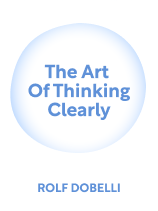

This article is an excerpt from the Shortform book guide to "The Art of Thinking Clearly" by Rolf Dobelli. Shortform has the world's best summaries and analyses of books you should be reading.
Like this article? Sign up for a free trial here .
What is false causality? Why do we assume causality where there is none?
Humans struggle to interpret cause and effect because they confuse correlation with causation, assuming causality where there is none. For example, if a person gets the flu after they start taking vitamins, they might assume a causal relationship—taking vitamins gave them the flu—simply because the timing coincides.
Let’s consider some ways the assumption of causality (where there’s none) impairs logic.
The Result Illusion
One instance in which people often assume false causality is the result illusion, which Dobelli calls the “swimmer’s body illusion.” In this bias, you look at the traits of people who do a certain activity and think the activity causes those traits. In reality, the people participate in the activity because they already have those traits. The traits are the cause, not the effect. For example, you might look at a professional swimmer’s toned body and think you can gain that same appearance by swimming. However, these individuals are so good at swimming because they already had that kind of body.
Dobelli suggests using your knowledge of the result illusion to make realistic goals. If you confuse the cause (swimmers’ body type) with the effect (they’re good swimmers), you might set unrealistic goals, like swimming to gain a different body type. If you realize the swimmers were born with that body type, you can set healthier goals for exercising that fit your own body type.
Ignoring Coincidence
Another way people misinterpret the cause-and-effect cycle is by ignoring coincidence, Dobelli states. People attribute strange events to the supernatural—for example, believing someone getting struck by lightning twice is a message from God or the universe—because they think such events are impossible and can’t be the result of coincidence.
In reality, these strange events are possible, though unlikely. People can’t accurately estimate probability (which we’ll discuss further in Chapter 8), so they think strange events are less likely than they actually are. Continuing our example, someone getting struck by lightning twice seems impossible, but with 7.7 billion people on earth and 1.4 billion lightning strikes per year, it’s bound to happen eventually.
Thus, don’t get too excited when something unusual happens, Dobelli suggests. Hardly anything is impossible, and the probability of any event occurring is likely higher than you think.
Association Bias
In this section, we’ll discuss another misrepresentation of cause and effect: association bias, or the brain’s tendency to make connections where none exist. Dobelli says this misrepresents cause and effect by forming false knowledge, where you falsely causally connect two unrelated things.
Superstitions form this way, Dobelli explains. For example, say you bring rainboots when camping, and the weather is perfect. The next time you go camping, you leave the rainboots behind and the weather is awful. The next time you bring them, the weather is wonderful again. After a few of these experiences, your brain connects the boots and good weather, even though it’s just a coincidence that the weather improved when you brought the boots.
Association bias is also involved in traumatic experiences, Dobelli adds. Say you step in a hole and break your leg while playing soccer. Your brain makes a connection between soccer and pain, and you may refuse to play soccer again. Because these connections have stronger inciting incidents—breaking a leg is more memorable than bringing boots—they can be very strong even after a single incident, while more innocuous connections must be reinforced over time.
The Fallacy of the Single Cause
In this section, we’ll cover the fallacy of the single cause: To make a simple pattern of cause and effect, people oversimplify chains of events, Dobelli says. They do this because, as previously mentioned, humans dislike uncertainty, including uncertainty over how events transpire. Looking for simple patterns reduces uncertainty because the fewer elements involved in a situation, the easier it is to understand the chain of events.
(Shortform note: As Dobelli implies, a single-cause pattern provides a sense of understanding. When people understand a situation, not only are they less uncertain, but they can also better withstand any uncertainty they do feel. In addition, understanding something increases confidence and positive feelings, which further encourages people to simplify the cause-and-effect cycle.)
This mindset is dangerous because everything is affected by a complex web of influences and causes, Dobelli adds. There’s never a single cause for large, complex effects like crime or success. Trying to find one leads people to pin responsibility on a single person or group. Blaming a single person or group alleviates everyone else’s guilt without addressing systemic problems, which lets the problems continue unhindered.

———End of Preview———
Like what you just read? Read the rest of the world's best book summary and analysis of Rolf Dobelli's "The Art of Thinking Clearly" at Shortform .
Here's what you'll find in our full The Art of Thinking Clearly summary :
- A detailed look at the most common logical fallacies that inhibit decision-making
- How to recognize and overcome these fallacies to make better decisions
- Why you value things for arbitrary reasons






